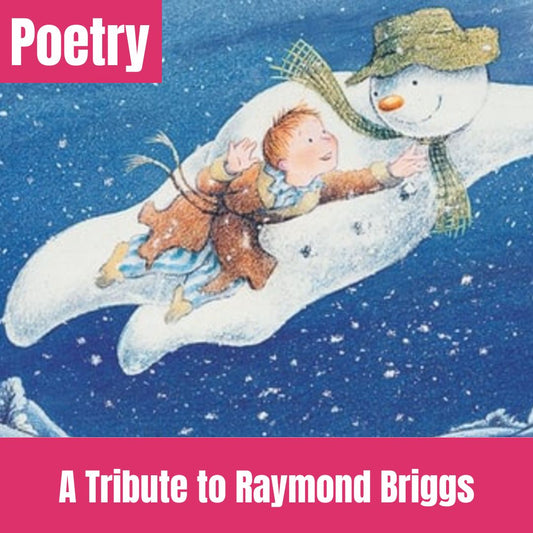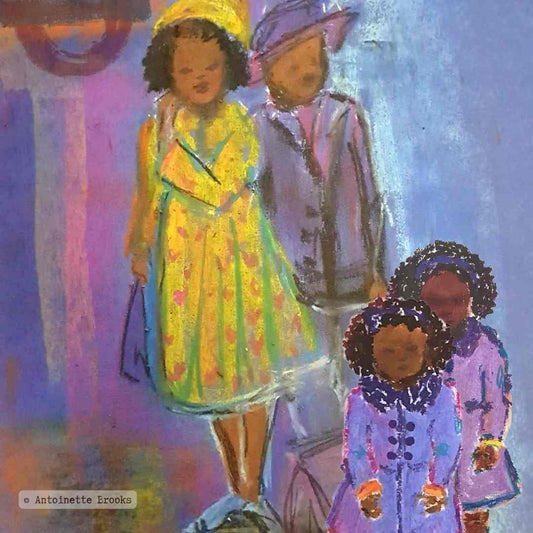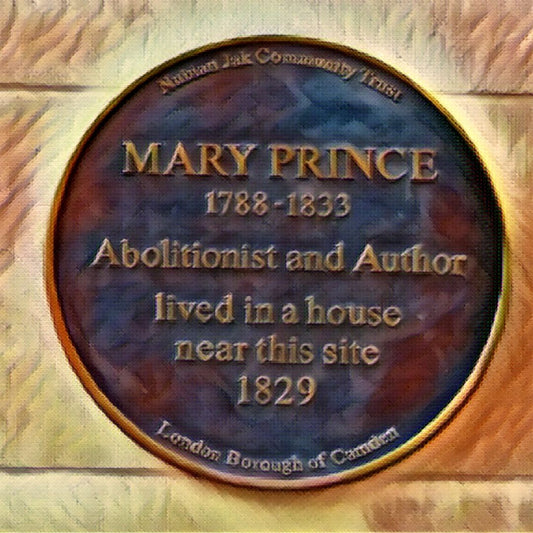
INSIDE: Mary Prince was born a slave in the Caribbean. She spent most of her life being sold from one brutal slave-owner to another. Yet she used the power of storytelling to change the world - and history. Here's her story...
This illustration was inspired but The Autobiography of Mary Prince, as Narrated by herself.
This is the biography of Mary Prince, the first Black British woman to tell her story. Her book is both a painful and powerful story. Coming from Caribbean ancestry, it made me wonder about the stories of my ancestors and the experiences they had endured too. Too often the tales of those who came before us have been lost or generalised as part of "the slave experience."
With Mary Prince, we have the only first hand account of a sla
"At last I took courage and resolved that I would not be longer thus treated, but would go and trust to Providence..."
- Mary Prince, The History of Mary Prince, a West Indian Slave. Related by Herself
_____________________________________
The year was 1800 and 12-year-old Mary Prince stood in the centre of a market square in Hamilton, Bermuda. By her side were her two younger sisters, each of them clinging desperately to Mary’s skirts. And in the distance, Mary could see her mother weeping, unable to stop the flood of tears that cascaded down her cheeks.
“I weep today,” she had heard her mother say a few days eariler to a group of black women who tried to comfort her, “but your turn will come next.” One of the women who was holding a small baby, had held her child tightly to her chest, and turned away in despair.
As Mary stood in the market, arms folded tightly across her chest, she was pinched and turned around by strange men in the same manner that a butcher would handle a piece of meat.
Soon the bidding started, and so did the horrible and unrepeatable remarks. When the hammer fell Mary was sold for £57 to a John Ingram from Spanish Point, whilst her younger sisters were sold to two separate owners. Mary did not see them again.
That evening Mary was taken to Spanish Point, the location of Ingham's spacious villa, built in the shade of a large hill. Years later when she spoke about the Ingham's home, Mary shuddered as she recalled, “The stones and the timber were the best things in it; they were not so hard as the hearts of the owners.”
So who was this Mary Prince who was able to recall her life in such vivid detail and the moment that she was sold into slavery?
Who was Mary Prince?
Mary Prince was born in Brackish Pond, Bermuda in around the year 1788. She was named after her father, a slave whose only name was Prince (thus her surname) and a mother who was devoted to Mary and her younger siblings. Aged seven, she and her mother were sold to a Captain Williams who gifted Mary to his daughter Betsey as a playmate and companion. However, when Betsey's mother died and Williams decided to remarry, Mary’s life was torn apart as she and her sisters were sold to different slave-owners in order to raise funds for the wedding.
How did John Ingham treat Mary Prince?
John Ingham's home, courtesy of MaryPrince.org
Both Captain John Ingham and his wife were very cruel. They flogged Mary for the slightest thing.
A typical day consisted of taking the sheep and cows to pasture, preparing breakfast, feeding and dressing the Ingham children, rubbing down and feeding the horses, returning the cattle from pasture and feeding them, then preparing supper and getting the Ingham children ready for bed. If these tasks were not done quickly enough or perfectly then Mary and her fellow slaves were whipped until they bled.
One of the slaves, a young woman called Hetty, who had been particularly kind to Mary was whipped with such ferocity that she miscarried the child she was pregnant with and later died of her injuries.
Mary recalled that on one occasion when she protested at the treatment she received, Ingham tied her to a tree and administered 100 lashes across her back while his son stood by and counted. She was still a young teenager at this time. She tried to runaway and live in the countryside but her father searched for her and returned her to Ingham, fearing that she would not survive as a runaway slave.
After spending five years with the Inghams, Mary Prince went from owner to owner across the Caribbean.
She lived in both the Grand Turks and Antigua, and was forced to work in salt mines that ate away at her flesh and caused painful boils on her feet and legs. On other occasions she and the other slaves were starved until half-dead, with only dry corn to eat. They were still expected to work for up to 17 hours a day, and flogged and abused when they could not complete their tasks.
How did Mary Prince end up in England?
Finally Mary was sold for £67 to a John Wood and his wife. If Mary had hoped for better treatment, she was in for a rude awakening. They were as harsh to her as the Inghams had been all those years earlier.
When Mary was ill they left her to fend for herself in a shed, and Mary only survived due to the compassion of a fellow slave who came daily with a small portion of food.
“To be free is a sweet thing,”
- Mary Prince
Mary took in small odd jobs and tried to save in order to buy her freedom, but the Woods obstinately refused to free her. In 1826 she married a black man Daniel James, who had managed to save and purchase his freedom. This marriage angered the Woods so much that they beat her even more harshly. Although she was happy with James, in 1828 she travelled with the Woods to England in the rather misguided hope that the English air would help ease the constant pain she endured from years of ill-treatment.
One day, whilst doing the laundry for the Woods, Mary collapsed in pain and the English washer-women were horrified to see the scars and welts on Mary’s body. They helped Mary by washing the clothes for her as they saw she was too weak to manage it. The Woods' cook in England was so horrified at the treatment Mary received that she walked in protest.
Mary learned of the rights that people had in England to leave an employer if they were not treated properly.
“To be free is a sweet thing,” noted Mary.
How did Mary Prince Come to Tell her Life Story?
Thomas Pringle, Secretary for the Anti-Slavery Society
"I have been a slave myself. I know what slaves feel—I can tell by myself what other slaves feel, and by what they have told me. The man that says slaves be quite happy in slavery—that they don't want to be free—that man is either ignorant or a lying person. I never heard a slave say so,”
- Mary Prince
Mary finally escaped from the Woods in 1829 and found refuge in the Moravian Church. There, she met Thomas Pringle, secretary of the Anti Slavery Society, who gave her paid work and encouraged her to share her life story.
He was horrified when Mary spoke in detail of the brutality she had endured, and arranged for Mary’s life story to be published with any proftis used to help Mary herself.
People across Britain bought Mary’s book and for the first time were able to read about what it was like to live as a slave from the experience of a black woman. In the first year of printing, the book sold out three times. Some people found it hard to believe Mary's story. They doubted that people could be so cruel, so Pringle called upon a friend of his named Joseph Philips who had lived in Antigua for many years and knew both Mary Prince and the Woods family. He confirmed Mary's story.
Pringle's wife also wrote letters to doubters, explaining that she had seen for herself the many scars that laced Mary's back, the result of years of beatings.
"I have been a slave myself. I know what slaves feel—I can tell by myself what other slaves feel, and by what they have told me. The man that says slaves be quite happy in slavery—that they don't want to be free—that man is either ignorant or a lying person. I never heard a slave say so,” said Mary boldy.
Her narrative helped fuel the growing anti-slavery sentiment in Britain, and in 1833, two years after Mary's book was published, the Slavery Abolition Act was passed, and Mary was finally a free woman.
What Happened to Mary Prince In Later Life?
Then as suddenly as she appeared on the scene, Mary disappeared.
Whether she returned to her beloved husband in Antigua and enjoyed their freedom together is not known. It is suggested that after freedom, her life in England wasn't easy. But her words and life story remain as a first hand account of the horrors of slavery.
In 2007 a blue plaque was unveiled in Bloomsbury by a group called Nubian Jak, on the spot of the house where Mary once lived, to remember and commemorate her life.







